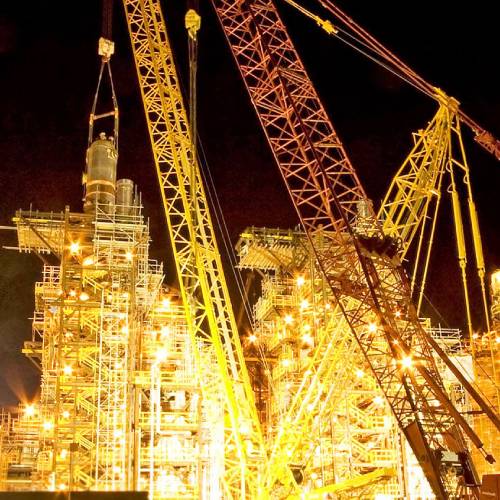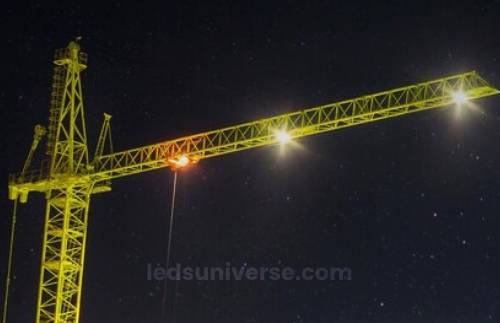In a world where every energy choice matters, this innovative lighting solution not only enhances visibility but also reduces reliance on fossil fuels and cuts operational costs. Curious about how solar crane lighting works and its many benefits? Dive into the details of this cutting-edge technology and discover how it’s transforming construction sites into safer and greener spaces.
The construction industry continuously seeks innovative solutions to improve efficiency and reduce environmental impact. One such advancement is solar crane lighting, a technology that harnesses solar energy to power lighting systems for cranes and other construction equipment. As projects often extend into the evening or require illumination in dimly lit areas, proper lighting is indispensable for maintaining productivity and ensuring worker safety. Solar crane lighting offers a sustainable approach, integrating renewable energy sources to illuminate work sites effectively.
Reach out for free lighting consultation
Table of Contents
ToggleSolar crane lighting presents numerous advantages, particularly in the areas of environmental sustainability, operational cost reduction, and safety enhancement. By shifting to solar-powered lighting, construction companies can align with global efforts to reduce reliance on fossil fuels while promoting eco-friendly practice
One of the most notable advantages lies in its contribution to environmental sustainability. Utilizing solar energy significantly decreases greenhouse gas emissions, which aligns with the growing commitment to eco-friendly practices in construction. By employing solar lighting systems, companies can minimize their carbon footprint and contribute to a cleaner environment. Solar crane lighting systems rely on photovoltaic panels that convert sunlight into electricity, generating clean energy that is free from harmful emissions. This not only reduces pollution but also supports the industry’s shift towards renewable energy sources.
Traditional lighting systems often require a constant supply of electricity, leading to substantial energy costs over time. With solar crane lighting, initial investments in solar panels and installation may be offset by long-term savings on electricity bills. The reduction in operational costs can free up resources for other project areas. Additionally, solar lighting systems typically require less maintenance than traditional systems, resulting in further cost savings over their lifespan.
Enhancing safety is another compelling reason to adopt solar crane lighting. Well-lit job sites improve visibility, allowing workers to perform tasks more efficiently and reducing the risk of accidents. Poor lighting conditions can lead to missteps, falls, and other hazardous situations. By ensuring that cranes and surrounding areas are adequately illuminated, the risk of injury is significantly lowered. Improved visibility also aids in the identification of potential hazards, enabling workers to take proactive measures.
Furthermore, the installation of solar crane lighting contributes to the overall work environment. Well-lit sites foster a sense of security among workers, enhancing morale and productivity. Workers are more likely to feel confident in their ability to perform tasks safely when they can see clearly. The combination of improved visibility, reduced risks, and heightened worker morale creates a more effective and efficient construction site.
Understanding the components of solar crane lighting systems provides insight into how these technologies operate and what makes them effective. A typical solar crane lighting system comprises solar panels, LED lights, batteries for energy storage, and control systems for operation management.
Solar panels serve as the backbone of any solar lighting system. They capture sunlight and convert it into electricity through photovoltaic cells. Various types of solar panels are available, each with distinct efficiencies and power outputs. When selecting panels for a crane lighting system, considerations such as size, capacity, and installation location come into play. The optimal positioning of solar panels ensures they receive maximum sunlight exposure throughout the day, thus enhancing energy generation.
LED lights have gained popularity in construction lighting due to their energy efficiency and longevity. Compared to traditional incandescent or halogen bulbs, LEDs consume significantly less power while providing brighter illumination. Their lower energy requirements mean that more lights can be powered from a single solar panel installation. Additionally, LEDs have a longer lifespan, reducing the frequency of replacements and contributing to lower maintenance costs.
Batteries play a significant role in storing energy generated by solar panels. During the day, excess energy is stored in batteries, allowing the system to provide illumination even when sunlight is unavailable. Several types of batteries are commonly used in solar crane lighting systems, including lithium-ion, lead-acid, and gel batteries. Each type has its advantages and disadvantages, including factors such as lifespan, efficiency, and cost. Selecting the right battery for a solar crane lighting system depends on specific project requirements and the desired balance between performance and budget.
Control systems facilitate the efficient operation of solar crane lighting systems. These systems can include automatic sensors that detect ambient light levels, ensuring that the lights turn on and off as needed. Some advanced control systems may offer remote management capabilities, enabling operators to monitor and adjust lighting settings from a distance. The integration of smart technologies into solar crane lighting systems enhances their functionality, allowing for more adaptable and user-friendly operations.
While the advantages of solar crane lighting are compelling, certain challenges and considerations can affect its implementation. Weather dependence, initial investment costs, and regulatory issues are among the factors that need careful evaluation.
Solar panels rely on sunlight to generate electricity, and prolonged periods of cloudy or rainy weather can hinder energy production. In regions with fluctuating weather patterns, the reliability of solar power may be a concern. It is vital to conduct a thorough analysis of local weather conditions when designing and installing solar crane lighting systems to ensure they can meet energy demands year-round. To mitigate this challenge, integrating additional energy storage solutions or hybrid systems that incorporate conventional power sources can help maintain consistent illumination during adverse weather conditions.
Initial investment costs can also pose a barrier to the adoption of solar crane lighting. Although the long-term savings on energy bills may outweigh these costs, the upfront expenses associated with purchasing and installing solar panels, batteries, and lighting systems can be substantial. Construction companies may need to consider financing options or seek incentives and grants to offset these initial costs. Thoroughly evaluating the total cost of ownership, including installation, maintenance, and operational costs, is crucial for making informed decisions about adopting solar crane lighting technologies.
Regulatory and compliance issues may arise during the installation of solar crane lighting systems. Local regulations concerning construction sites and electrical installations can vary significantly from one area to another. Companies must ensure that their solar lighting systems comply with safety standards and building codes. Engaging with local authorities early in the planning process can help streamline approvals and ensure that the systems installed meet all necessary requirements.
Addressing these challenges requires careful planning and strategic decision-making. Engaging with experts in solar technology and construction can help navigate the complexities of implementing solar crane lighting. A collaborative approach, involving stakeholders from various disciplines, can enhance the likelihood of successful project outcomes.
Exploring innovative solutions, such as advancements in battery technology and hybrid systems, can also enhance the viability of solar crane lighting. Continuous research and development within the solar industry are leading to more efficient and cost-effective technologies. Embracing these innovations can provide construction companies with more reliable options for illuminating job sites.
Integrating solar crane lighting into construction projects contributes to a forward-thinking approach that embraces sustainability and efficiency. By understanding the benefits, components, and challenges of solar crane lighting systems, companies can make informed decisions that align with their operational goals and environmental commitments.
Educating the workforce about the advantages and proper use of solar crane lighting can enhance its effectiveness. Workers equipped with knowledge about the technology can maximize its benefits and contribute to a safer, more productive work environment. Providing training sessions and resources about solar lighting can foster a culture of safety and innovation on construction sites.
The evolution of solar crane lighting systems represents a step forward in the construction industry’s efforts to adopt sustainable practices. By leveraging renewable energy sources, companies can illuminate job sites while reducing their environmental impact. This alignment with eco-friendly practices not only benefits the planet but also positions construction firms as responsible stewards of resources.

The integration of solar crane lighting systems with smart technologies offers further advancements in energy efficiency and operational effectiveness. As the Internet of Things (IoT) becomes more prevalent in construction, solar lighting systems can be enhanced with sensors, data analytics, and remote monitoring capabilitie
For instance, smart sensors can detect ambient light levels and automatically adjust the brightness of the solar lights accordingly. This adaptive lighting not only optimizes energy consumption but also ensures that areas are adequately illuminated based on real-time conditions. Furthermore, data analytics can provide insights into energy usage patterns, helping project managers identify peak usage times and optimize battery storage and solar panel placement for maximum efficiency.
While solar crane lighting systems generally require less maintenance than traditional lighting solutions, some upkeep is necessary to ensure optimal performance. Regular inspections of solar panels and battery systems are important to identify any dirt or debris that might hinder sunlight absorption. Cleaning solar panels periodically can help maintain their efficiency and prolong their lifespan.
Monitoring battery health, ensuring proper charging cycles, and replacing batteries as needed can prevent system failures. By implementing a regular maintenance schedule, construction companies can maximize the longevity of their solar lighting systems and avoid unexpected downtime.
Various construction companies have successfully implemented solar crane lighting systems, demonstrating their effectiveness and benefits. One notable case involved a large-scale infrastructure project where traditional lighting methods were both costly and energy-intensive. By switching to solar crane lighting, the project team not only reduced energy consumption but also experienced a significant decrease in the project’s overall carbon emissions.
In another instance, a construction firm operating in a remote area faced challenges related to electricity supply. Traditional generators were costly to operate and often failed due to fuel shortages. By implementing solar lighting systems, the company provided reliable illumination for its cranes and work areas without depending on external power sources. This transition resulted in substantial savings, improved safety, and enhanced worker satisfaction.
These success stories highlight the practical benefits of adopting solar crane lighting solutions. They also serve as examples for other companies looking to make similar transitions in their operations.
Embracing solar crane lighting signifies a broader commitment to sustainability in the construction industry. By understanding the components, benefits, and challenges associated with solar lighting systems, construction companies can make informed choices that contribute to a greener future. The integration of innovative technologies and smart systems will only enhance the effectiveness and viability of these solutions.
The shift towards renewable energy sources in construction not only reflects a response to global environmental challenges but also opens new avenues for operational efficiencies and cost savings. As solar crane lighting technology continues to evolve, it promises to redefine how construction sites are illuminated, providing safer and more sustainable environments for workers.
By remaining adaptable and open to advancements in solar technology, the construction industry can lead the way in fostering a more sustainable future, proving that the integration of innovative solutions is not just a trend but a necessary evolution in construction practices.